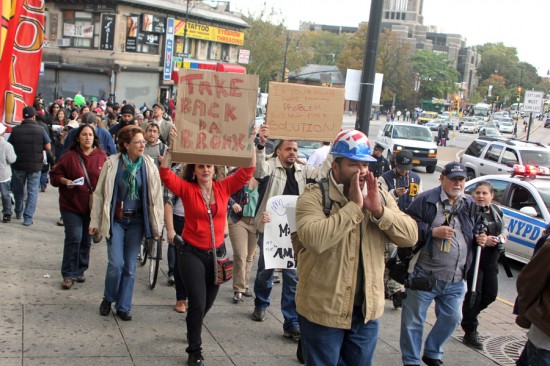
“The Bronx is in the house,” thundered 60 or 70 people last Saturday afternoon as they marched into a public square in lower Manhattan.
The chant announced their presence to more than a thousand demonstrators already assembled in Zuccotti Park to protest against corporate greed and a government that serves business and the wealthy at the expense of ordinary people.
Occupy the Bronx had joined Occupy Wall Street.
It’s about time.
Occupy Wall Street is about the sickening disparity between the prosperity of the rich and the worsening conditions of everyone else.
It’s about the fact that the top 1 percent of Americans has accumulated more wealth than the bottom 90 percent.
It’s about a government that fails to connect the fact that it has spent more than a trillion dollars on the wars in Iraq and Afghanistan with the fact that sick people can’t get health care and able-bodied people can’t find jobs.
It’s about politicians—Republicans and Democrats, from the President of the United States to the lowliest member of the City Council–who serve the 1 percent because they have been purchased with the campaign contributions that keep them in office.
Saying such things encourages class warfare, critics warn. Here’s what class warfare really looks like. It looks like the young woman who spoke to a crowd at Fordham Plaza, telling them that with her masters degree in social work and a job helping ex-convicts she earns $28,000 and is being crushed under the weight of student loans.
It looks like the Upper East Side organization battling against the city’s plan to share the burden of garbage disposal whose leader says that instead of building a waste transfer station in his neighborhood the city should put the facility in Hunts Point.
“The Bronx has for too long been dumped on. We get all of the waste,” said Omar Freilla, one of the organizers of Occupy the Bronx, addressing the hundred or so people who rallied at Fordham Plaza before they marched up Fordham Road and boarded a subway to the Wall Street demonstrations together.
“We get developers who get all of the tax breaks and incentives to build malls that pay not even a living wage” and a government that helps out the richest sports team in the nation at the expense of the people in the poorest Congressional District in the United States, Freilla continued.
Class warfare looks like lines at food pantries in Mott Haven that are running out of food. It looks like the unemployment lines in a borough where the official jobless rate is almost twice that of the state, and the number of discouraged workers, underemployed workers and undocumented workers approaches 50 percent.
The Bronx needs the passion of the Occupy Wall Street movement, and Occupy Wall Street needs the Bronx. “We’re the diversity that Occupy Wall Street has been waiting for,” said Ephraim Cruz, another of the organizers of Occupy the Bronx to the crowd at Fordham Plaza, which, like the borough as a whole, was mostly Latino.
Occupy the Bronx will meet at Fordham Plaza near the Metro-North station every Saturday at 11 a.m. Join in. Show the world that the Bronx is in the house.
